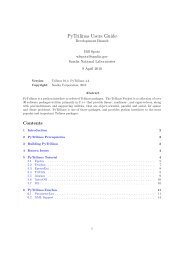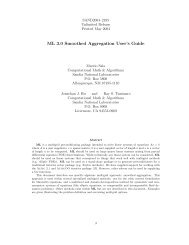nonsymmetric dynamics
ML 5.0 Smoothed Aggregation User's Guide - Trilinos - Sandia ...
ML 5.0 Smoothed Aggregation User's Guide - Trilinos - Sandia ...
- No tags were found...
You also want an ePaper? Increase the reach of your titles
YUMPU automatically turns print PDFs into web optimized ePapers that Google loves.
6.6 Analyzing the ML preconditioner<br />
A successful multilevel preconditioner require the careful choice of a large variety of parameters,<br />
for instance each level’s smoother, the aggregation schemes, or the coarse solver. Often,<br />
for non-standard problems, there is no theory to support these choices. Also, sometimes it<br />
is difficult to understand which component of the multilevel cycle is not properly working.<br />
To help to set the multilevel components, ML offers a set of tools, to (empirically) analyze<br />
several components of the multilevel cycles, and the finest-level matrix.<br />
Two examples are included in the ML distribution:<br />
• File examples/Visualization/ml_viz.cpp shows how to visualize the effect of the<br />
ML cycle and each level’s smoother on a random vector;<br />
• File examples/Advanced/ml_analyze.cpp shows who to get some quantitative information<br />
about each level’s matrix, and multilevel preconditioner.<br />
In the following subsections, we suppose that a MultiLevelPreconditioner object has<br />
already be defined, and the preconditioner computed.<br />
6.6.1 Cheap Analysis of All Level Matrices<br />
Method AnalyzeMatrixCheap() will report on standard output general information about<br />
each level’s matrix. An example of output is as reported below. (Here, we report only the<br />
part of output related to the finest level.)<br />
*** Analysis of ML_Operator ‘A matrix level 0’ ***<br />
Number of global rows = 256<br />
Number of equations = 1<br />
Number of stored elements = 1216<br />
Number of nonzero elements = 1216<br />
Mininum number of nonzero elements/row = 3<br />
Maximum number of nonzero elements/row = 5<br />
Average number of nonzero elements/rows = 4.750000<br />
Nonzero elements in strict lower part = 480<br />
Nonzero elements in strict upper part = 480<br />
Max |i-j|, a(i,j) != 0 = 16<br />
Number of diagonally dominant rows = 86 (= 33.59%)<br />
Number of weakly diagonally dominant rows = 67 (= 26.17%)<br />
Number of Dirichlet rows = 0 (= 0.00%)<br />
||A||_F = 244.066240<br />
Min_{i,j} ( a(i,j) ) = -14.950987<br />
Max_{i,j} ( a(i,j) ) = 15.208792<br />
Min_{i,j} ( abs(a(i,j)) ) = 0.002890<br />
Max_{i,j} ( abs(a(i,j)) ) = 15.208792<br />
Min_i ( abs(a(i,i)) ) = 2.004640<br />
Max_i ( abs(a(i,i)) ) = 15.208792<br />
Min_i ( \sum_{j!=i} abs(a(i,j)) ) = 2.004640<br />
36







